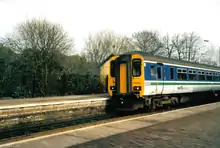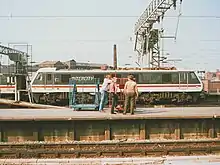British Rail brand names
British Rail was the brand image of the nationalised railway owner and operator in Great Britain, the British Railways Board, used from 1965 until its breakup and sell-off from 1993 onwards.

From an initial standardised corporate image, several sub-brands emerged for marketing purposes, and later in preparation for privatisation. These brands covered rail networks, customers services, and several classes of new trains.
With the size of British Rail's fleet, due to the time required to repaint rolling stock, in terms of the physical trains brand switchovers could be lengthy affairs lasting years. This worsened into privatisation, with the same services often using 3 or 4 different liveries.
Following privatisation, several of the brands disappeared, although some brand names such as ScotRail, Merseyrail, Eurostar and Freightliner still exist today.
The double-arrow symbol introduced with the creation of the British Rail brand in the 1960s, still remains after privatisation, as a unifying branding device used by the privatised National Rail network, and shown on most tickets, stations, timetables and publicity, but not trains.
Timeline of brands
Under the Transport Act 1962, responsibility for the state railway operation, British Railways, was transferred from being a trade name and subsidiary of the British Transport Commission, to a separate public corporation, under the British Railways Board.
As the last steam locomotives were being withdrawn (completed in 1968) under the 1955 Modernisation Plan, the corporation's public name was re-branded in 1965 as British Rail, which introduced the double-arrow symbol, a standard typeface (named Rail Alphabet) and the BR blue livery, applied to nearly all locomotives and rolling stock.
The first major BR sub-brand to appear was InterCity brand. This was augmented with the InterCity 125 brand in 1976, in conjunction with the introduction of the InterCity 125 High Speed Train.
In the 1980s under sectorisation blue livery was phased out as the organisation converted from a regional structure to being sector-based. The Intercity brand was relaunched, and passenger brands Network SouthEast and Regional Railways introduced, seeing these divisions introduce many sub-brands. Freight operations were split into the Trainload Freight, Railfreight Distribution and Rail Express Systems sectors.
In the late 1980s and early 1990s, new multiple-unit train designs being introduced to replace rolling stock also brought new brand names, often linked to other branding exercises, such as the Networkers specially built for Network SouthEast.
In the 1990s, BR created the European Passenger Services division, to run passenger services through the Channel Tunnel, under the Eurostar brand. After construction delays, this was operated from 1994, until it passed to the London and Continental Railways consortium in 1996 as Eurostar.
In preparation for privatisation, the freight sectors were further split into smaller business functions, as regional splits of Trainload Freight, or further splits along customer market, such as inter-modal traffic, each with their own branding. With almost all freight businesses going straight to EWS, most of these brands were short lived.
List of brands
Networks
- Island Line - passenger services on the Isle of Wight (Ryde - Shanklin) from 1989. Part of Network SouthEast.
- Merseyrail - a passenger service brand for Merseyside.
- Network NorthWest - passenger service brand paralleling Network SouthEast for Greater Manchester and Lancashire introduced in 1989[1] as part of Regional Railways. After a few years it was replaced by the Regional Railways branding.

- Network SouthEast (originally London & South Eastern) - commuter and medium-distance trains operating in an area bounded roughly by King's Lynn, Peterborough, Worcester, Bedwyn, Exeter and Weymouth and included the Waterloo & City line, which is now part of the London Underground.
- Regional Railways (originally Provincial) - other passenger services in England and Wales, often suffixed by a regional description, e.g. Regional Railways North West
- Ryde Rail - passenger services on the Isle of Wight (Ryde - Shanklin) 1985-1989.[2] Part of Network SouthEast from 1987.
- ScotRail - passenger services within Scotland (officially part of Regional Railways, but with a distinct identity)
- Strathclyde Transport - brand operated by ScotRail on behalf of Strathclyde Regional Council. Strathclyde transport operating commuter services within Greater Glasgow and the wider Strathclyde area, and had its own distinct livery (orange/black from 1983, carmine/cream from 2000 onward). The brand survived privatisation and was later shortened to SPT, but disappeared completely when responsibility for co-ordinating rail services was taken away from SPT following the Transport (Scotland) Act 2005 when Strathclyde Passenger Transport Executive (and Authority), along with the WESTRANS voluntary regional transport partnership, were replaced by the Strathclyde Partnership for Transport..
- Tynerail and Tynerider - passenger service brand for Tyneside (pre Tyne & Wear Metro).
Express passenger services
- Alphaline - sub-brand of Regional Railways, for regional express services on secondary routes, operated using 90 mph Class 158 trains, complementing the InterCity network.
- Eurostar - an international high speed passenger train service connecting London with Paris and Brussels through the Channel Tunnel using Network SouthEast mainline tracks in Britain.
- InterCity - high-speed express trains connecting major towns and cities.

Other services
- Motorail - long-distance passenger services that also carried cars (operated as part of InterCity)
- Pullman - first Class carriages in InterCity trains offering a full at-seat catering service (mainly marketed to business travellers)
- Railair - through ticketing service for coach links to airports.
- Sealink - ferry services.
Freight Services
- Rail Express Systems - Royal Mail Post Office and parcels services
- Red Star Parcels - express parcel delivery
- Trainload Freight - whole-train services, divided into sub-sectors covering Coal, Construction, Metals and Petroleum
- Freightliner - container services
- Speedlink - wagonload services
Rolling stock classes
| Brand Name | Unit Classes | |
|---|---|---|
| Diesel Units | ||
| Blue Pullman | 251 | |
| Trans-Pennine | 124 | |
| Heritage | 100 to 131 | |
| InterCity 125 (or High Speed Train) | 253, 254 (later Class 43 and Mark 3 hauled coaching stock) | |
| Pacer (or Skipper on Western Region) | 140, 141, 142, 143, 144 | |
| Sprinter-family | Sprinter | 150 |
| Super-Sprinter | 153, 155, 156 | |
| 'Express-Sprinter' or 'Express' | 158 | |
| South Western Turbo | 159 (Network SouthEast) | |
| Turbo-family | Network Turbo | 165 |
| Network Express Turbo | 166 | |
| Clubman† | 168 | |
| Electric Units | ||
| Advanced Passenger Train | 370 | |
| Blue Train | 303, 311 | |
| Clacton Express | 309 | |
| Eurostar | 373 | |
| InterCity 225* | 91 and Mark 4 hauled coaching stock | |
| Networker | 365, 465, 466 | |
| Wessex Electric | 442 | |
† The Clubman was never operated by British Rail. Network SouthEast planned it was their new service to Birmingham (via the Chiltern Main Line) and nicknamed it the Clubman but privatisation intervened. New private operators, Chiltern Railways (former Chiltern Line managers) ordered 5 168/0s, which were only cosmetically different from the units planned by NSE, in 1996.
* The InterCity 225 is not a multiple unit - sets are made up of a single Class 91 electric locomotive, 9 Mark 4 coaches and a Mark 4 Driving Van Trailer.
References
- "Archived copy". Archived from the original on 16 November 2013. Retrieved 30 June 2014.CS1 maint: archived copy as title (link)
- Hardy, Brian (2003). Tube Trains on the Isle of Wight. Harrow Weald, Middlesex: Capital Transport. pp. 38, 75. ISBN 1-85414-276-3.